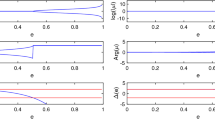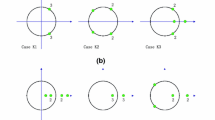Abstract
We studied systematically cases of the families of non-symmetric periodic orbits in the planar restricted three-body problem. We took interesting information about the evolution, stability and termination of bifurcating families of various multiplicities. We found that the main families of simple non-symmetric periodic orbits present a similar dynamical structure and bifurcation pattern. As the Jacobi constant changes each branch of the characteristic of a main family spirals around a focal point-terminating point in x- at which the Jacobi constant is C ∞ = 3 and their periodic orbits terminate at the corotation (at the Lagrangian point L4 or L5). As the family approaches asymptotically its termination point infinite changes of stability to instability and vice versa occur along its characteristic. Thus, infinite bifurcation points appear and each one of them produces infinite inverse Feigenbaum sequences. That is, every bifurcating family of a Feigenbaum sequence produces the same phenomenon and so on. Therefore, infinite spiral characteristics appear and each one of them generates infinite new inner spirals and so on. Each member of these infinite sets of the spirals reproduces a basic bifurcation pattern. Therefore, we have in general large unstable regions that generate large chaotic regions near the corotation points L4, L5, which are unstable. As C varies along the spiral characteristic of every bifurcating family, which approaches its focal point, infinite loops, one inside the other, surrounding the unstable triangular points L4 or L5 are formed on their orbits. So, each terminating point corresponds to an asymptotic non-symmetric periodic orbit that spirals into the corotation points L4, L5 with infinite period. This is a new mechanism that produces very large degree of stochasticity. These conclusions help us to comprehend better the motions around the points L4 and L5 of Lagrange.
Similar content being viewed by others
References
Bardin B.: On motions near the Lagrange equilibrium point L4 in the case of Routh’s critical mass ratio. Celest. Mech. Dyn. Astron. 82, 163 (2002)
Bier M., Bountis T.: Remerging Feigenbaum trees in dynamical systems. Phys. Lett. A 104, 239 (1984)
Bruno A.D., Varin V.P.: The limit problems for the equation of oscillations of a satellite. Celest. Mech. Dyn. Astron. 67(1), 1–40 (1997)
Bruno A.D.: Families of periodic solutions to the Beletsky equation. Cosmic. Res. 40(3), 274–295 (2002)
Contopoulos G.: Inverse Feigenbaum sequences in Hamiltonian systems: Lett. Nuovo Cim. 37, 149 (1983a)
Contopoulos G.: Infinite bifurcations, gaps and bubbles in Hamiltonian systems. Physica D 8, 142 (1983b)
Contopoulos G.: The generation of spiral characteristics. Celest. Mech. Dyn. Astron. 50, 251 (1991)
Contopoulos G.: Order and Chaos. In: Contopoulos, G., Spyrou, N., Blahos, L. (eds) Galactic Dynamics and N-Body Simulations., pp. 33. Springer, New York (1993)
Contopoulos G.: Order and Chaos in Dynamical Astronomy. Springer, New York (2002)
Contopoulos G., Zikides M.: Periodic orbits and ergodic components of a resonant dynamical system. Astron. Astrophys. 90, 198 (1980)
Contopoulos G., Pinotsis A.D.: Infinite bifurcations in the restricted three-body problem. Astron. Astrophys. 133, 49 (1984)
Coullet, P., Tresser, C. Iterations d’ endomorphismes et groupe de renormalisation: J. Phys. Coll. (Paris), 39, C5 (1978)
Eckmann J.P.: Roads to turbulence in dissipative dynamical systems. Rev. Mod. Phys. 53, 643 (1981)
Efthymiopoulos C.: Formal Integrals and Nekhoroshev stability in a mapping model for the Trojan asteroids. Celest. Mech. Dyn. Astron. 92, 29 (2005)
Erdi B., Forgacs-Dajika E., Nagy I., Rajnai R.: A parametric study of stability and resonances around L4 in the elliptic restricted three-body problem. Celest. Mech. Dyn. Astron. 104, 145 (2009)
Feigenbaum M.J.: Quantitative universality for a class of nonlinear transformations. J. Stat. Phys. 19, 25 (1978)
Hadjidemetriou J.: Periodic orbits and stability, Programme Univer. Europ. Erasmus, Thessaloniki (1989)
Heggie D.C.: On the bifurcations of a certain family of periodic orbits. Celest. Mech. 29, 207 (1983)
Hénon M.: Exploration Numerique du probleme restreint, (II) Masses egales, stabilite des orbites periodiques. Ann. Astrophys. 28, 992–1007 (1965)
Henrard J., Navarro J.F.: Families of periodic orbits emanating from homoclinic in the restricted problem of three bodies. Celest. Mech. Dyn. Astron. 89, 285 (2004)
Magnenat P.: Periodic orbits in triaxial galactic models. Astron. Astrophys. 108, 89 (1982)
Pinotsis A.D.: Bifurcations, stability and universality of families of periodic orbits in the restricted three-body problem. Astron. Astrophys. 159, 231–238 (1986)
Pinotsis A.D.: Successive bifurcations and evolution of double and quadruple periodic orbits in the restricted three-body problem. Astron. Astrophys. 174, 317–322 (1987)
Pinotsis A.D.: Bifurcations and instabilities in the restricted three-body problem. In: Roy, A.E. (eds) Long Term Dynamical Behaviour of Natural andn Artificial N-Body Systems, pp. 465–469. Kluver Academic Publishers, Dordrecht (1988)
Sandor Z., Erdi B., Efthymiopoulos C.: The phase space structure around L4 in the restricted three-body problem. Celest. Mech. Dyn. Astron. 78, 113 (2000)
Sicardy B.: Stability of the triangular Lagrange points beyond Gascheaus’s value. Celest. Mech. Dyn. Astron. 107(1–2), 145–155 (2010)
Szebehely V.: Theory of Orbits. Academic Press, New York (1967)
Author information
Authors and Affiliations
Corresponding author
Electronic Supplementary Material
The Below is the Electronic Supplementary Material.
Rights and permissions
About this article
Cite this article
Pinotsis, A.D. Infinite Feigenbaum sequences and spirals in the vicinity of the Lagrangian periodic solutions. Celest Mech Dyn Astr 108, 187–202 (2010). https://doi.org/10.1007/s10569-010-9294-2
Received:
Revised:
Accepted:
Published:
Issue Date:
DOI: https://doi.org/10.1007/s10569-010-9294-2




